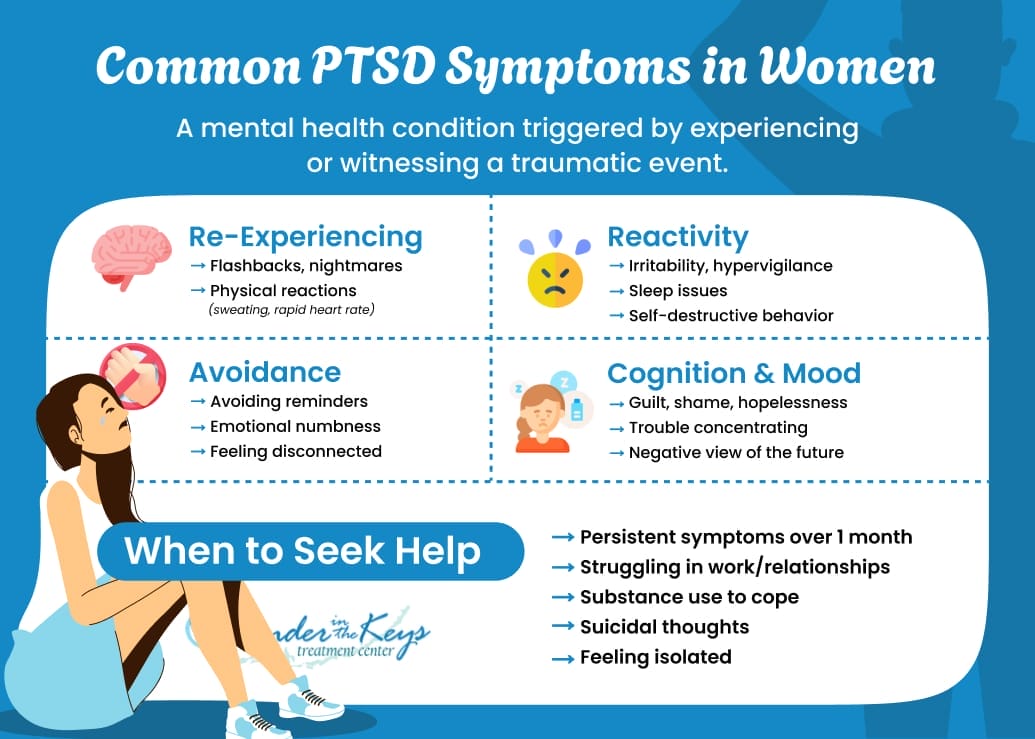Post-traumatic stress disorder affects millions of women across the country, yet many suffer in silence without recognizing their symptoms or understanding that recovery is possible. Understanding PTSD symptoms in women is a crucial step toward breaking this silence and beginning the journey to healing.
Awareness is the first step toward healing. If you’ve experienced a traumatic event and find yourself struggling with persistent feelings of distress, know that you’re not alone, and help is available.

What is PTSD, and Why Do Women Experience It Differently?
Post-traumatic stress disorder develops after exposure to a traumatic event that threatens one’s safety or makes one feel helpless. While anyone can develop PTSD, research shows that women are twice as likely as men to experience this mental health condition. This difference isn’t simply about emotional sensitivity—it reflects both biological factors and the types of trauma women more commonly face.
Women are more likely to experience certain types of trauma, including sexual assault and physical abuse, which carry a higher risk of developing PTSD afterward. Additionally, how the brain processes traumatic stress may differ between sexes, influencing how symptoms manifest and persist.
Recognizing PTSD Symptoms in Women
PTSD symptoms in women can sometimes look different than the stereotypical portrayal in media. Understanding these differences is crucial for proper diagnosis and treatment. The core symptoms typically fall into four categories:
Re-experiencing symptoms occur when women find themselves reliving the traumatic event repeatedly through intrusive memories, nightmares, or flashbacks. These aren’t simply “bad memories”—they’re intense, involuntary experiences that feel as if the trauma is happening all over again. Many women report physical responses during these episodes, including rapid heartbeat, sweating, and difficulty breathing.
Avoidance symptoms involve steering clear of anything that might trigger memories of the trauma. This might mean avoiding certain places, people, or activities. Women may also experience feeling emotionally numb, losing interest in previously enjoyed activities, or having trouble feeling positive emotions. Some describe this as feeling disconnected from themselves and others, as if watching life from behind a glass wall.
Reactivity symptoms include being easily startled, having angry outbursts, experiencing sleep difficulties, or engaging in self-destructive behavior. Women often report feeling constantly “on edge” or hypervigilant—scanning their environment for potential dangers even in safe situations. This state of high alert is exhausting and can lead to physical health problems over time.
Cognitive and mood symptoms involve negative thoughts about oneself or the world, distorted feelings of guilt or blame, and ongoing negative emotions like fear, horror, anger, or shame. Women may struggle with difficulty concentrating or remembering aspects of the traumatic event. Some report feeling as if their future has somehow been cut short or that life will never return to normal.

When PTSD Intersects With Other Mental Health Concerns
Women with PTSD often experience other mental health problems simultaneously. Depression, anxiety disorders, and substance abuse commonly co-occur with PTSD. This isn’t a sign of weakness—it’s a natural response to trauma and the ongoing stress it creates in the body and mind.
The relationship between these conditions is complex. Sometimes, PTSD symptoms lead to depression as women struggle with persistent feelings of hopelessness. In other cases, anxiety disorders develop as the body’s alarm system becomes chronically activated. Some women may turn to substances to manage symptoms, creating a cycle that ultimately worsens their condition.
Understanding these connections helps mental health professionals develop comprehensive treatment plans that address the full spectrum of needs rather than treating symptoms in isolation.
Seeking Help: When and How
Not everyone who experiences trauma will develop PTSD, but if symptoms last more than a month and significantly impact your daily functioning, it’s time to reach out to a mental health professional. Early intervention often leads to better outcomes.
Warning signs that indicate the need for professional help include:
- Symptoms that don’t improve or worsen over time
- Difficulty functioning at work or in relationships
- Using substances to cope with emotional pain
- Experiencing suicidal thoughts
- Feeling isolated or misunderstood by those around you
Remember that experiencing these symptoms doesn’t mean you’re “broken” or that you’ll never recover. PTSD is a treatable mental health condition, and with the right support, healing is possible.
Evidence-Based Treatments That Offer Hope
Treatment for PTSD typically involves psychotherapy (talk therapy), medication, or a combination of both. Two of the most effective therapy approaches are Cognitive Processing Therapy and Prolonged Exposure Therapy.
Cognitive Processing Therapy helps women examine and change unhelpful beliefs related to their trauma. By identifying and challenging these thoughts, women can reduce the power trauma holds over their lives and develop healthier perspectives.
Prolonged Exposure Therapy gradually and safely helps women confront trauma-related memories and situations they’ve been avoiding. Through this process, women learn that memories themselves aren’t dangerous and that avoidance actually maintains symptoms rather than reducing them.
Eye Movement Desensitization and Reprocessing (EMDR) is another effective approach that helps the brain process traumatic memories in new ways, reducing their emotional intensity.
Medication options may include selective serotonin reuptake inhibitors, which can help manage symptoms like depression and anxiety. Anti-anxiety medicine or sleep medications may be prescribed temporarily to address specific symptoms while therapy addresses the underlying trauma.

Building a Life Beyond Trauma
Recovery from PTSD isn’t just about symptom reduction—it’s about reclaiming your life and building resilience. Many women find that connecting with others who understand their experiences helps reduce feelings of isolation. Support groups, both in-person and online, can provide validation and practical coping strategies.
Self-care practices are also essential components of recovery. Regular physical activity, adequate sleep, mindfulness practices, and creative expression all help regulate the nervous system and rebuild a sense of safety in the body.
At Kinder in the Keys, we’ve witnessed countless women transform their relationship with trauma. While the journey isn’t always linear, with proper support and treatment, women can and do recover from PTSD. The symptoms that once felt overwhelming become manageable, and space opens up for joy, connection, and purpose once again.
Taking the First Step
If you recognize these symptoms in yourself or someone you love, know that reaching out for help is an act of courage, not weakness. Our compassionate team of mental health professionals specializes in trauma treatment and understands the unique ways PTSD symptoms in women can manifest.
Your experience matters, and recovery is possible. Contact us today to learn more about our services and how we can support you on your healing journey.
